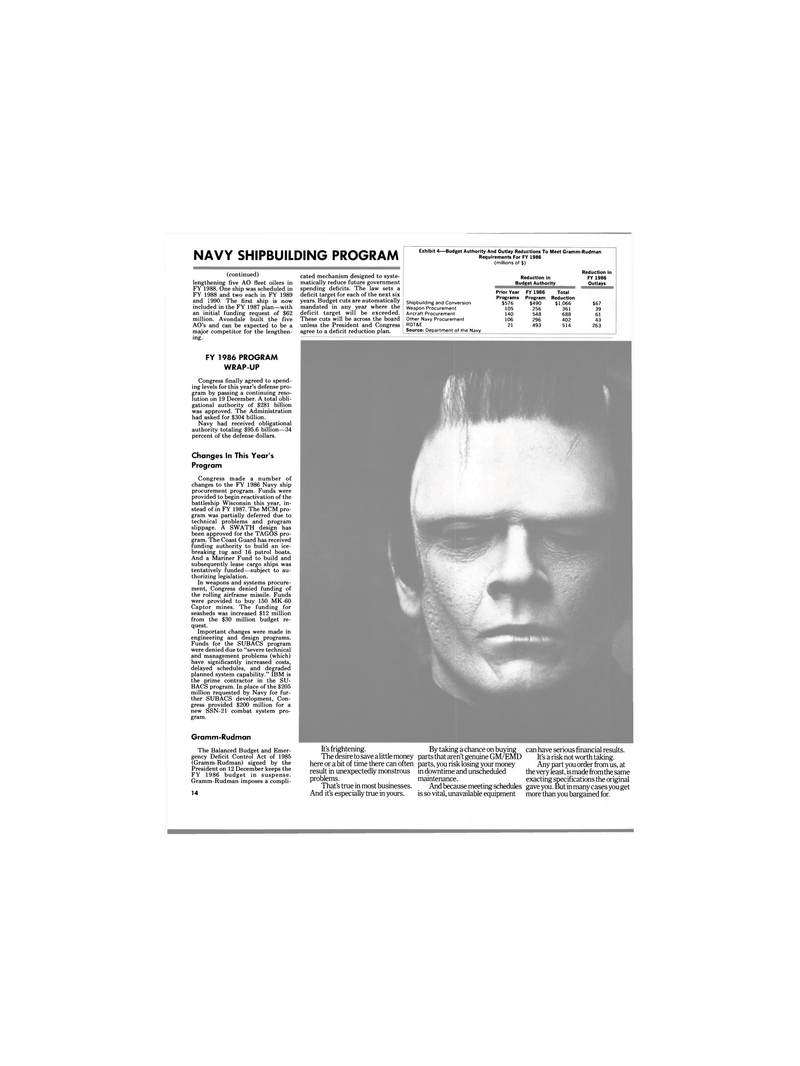
Page 12: of Maritime Reporter Magazine (March 1986)
Read this page in Pdf, Flash or Html5 edition of March 1986 Maritime Reporter Magazine
NAVY SHIPBUILDING PROGRAM Exhibit 4—Budget Authority And Outlay Reductions To Meet Gramm-Rudman Requirements For FY 1986 (millions of $) (continued) lengthening five AO fleet oilers in
FY 1988. One ship was scheduled in
FY 1988 and two each in FY 1989 and 1990. The first ship is now included in the FY 1987 plan—with an initial funding request of $62 million. Avondale built the five
AO's and can be expected to be a major competitor for the lengthen- ing.
FY 1986 PROGRAM
WRAP-UP
Congress finally agreed to spend- ing levels for this year's defense pro- gram by passing a continuing reso- lution on 19 December. A total obli- gational authority of $281 billion was approved. The Administration had asked for $304 billion.
Navy had received obligational authority totaling $95.6 billion—34 percent of the defense dollars.
Changes In This Year's
Program
Congress made a number of changes to the FY 1986 Navy ship procurement program. Funds were provided to begin reactivation of the battleship Wisconsin this year, in- stead of in FY 1987. The MCM pro- gram was partially deferred due to technical problems and program slippage. A SWATH design has been approved for the TAGOS pro- gram. The Coast Guard has received funding authority to build an ice- breaking tug and 16 patrol boats.
And a Mariner Fund to build and subsequently lease cargo ships was tentatively funded—subject to au- thorizing legislation.
In weapons and systems procure- ment, Congress denied funding of the rolling airframe missile. Funds were provided to buy 150 MK-60
Captor mines. The funding for seasheds was increased $12 million from the $30 million budget re- quest.
Important changes were made in engineering and design programs.
Funds for the SUBACS program were denied due to "severe technical and management problems (which) have significantly increased costs, delayed schedules, and degraded planned system capability." IBM is the prime contractor in the SU-
BACS program. In place of the $205 million requested by Navy for fur- ther SUBACS development, Con- gress provided $200 million for a new SSN-21 combat system pro- gram.
Gramm-Rudman
The Balanced Budget and Emer- gency Deficit Control Act of 1985 (Gramm-Rudman) signed by the
President on 12 December keeps the
FY 1986 budget in suspense.
Gramm-Rudman imposes a compli- 14 cated mechanism designed to syste- matically reduce future government spending deficits. The law sets a deficit target for each of the next six years. Budget cuts are automatically mandated in any year where the deficit target will be exceeded.
These cuts will be across the board unless the President and Congress agree to a deficit reduction plan.
Reduction in
Budget Authority
Reduction in
FY 1986
Outlays
Prior Year FY 1986 Total
Programs Program Reduction
Shipbuilding and Conversion $576 $490 $1,066 $67
Weapon Procurement 105 256 361 39
Aircraft Procurement 140 548 688 61
Other Navy Procurement 106 296 402 43
RDT&E 21 493 514 263
Source: Department of the Navy
It's frightening.
The desire to save a little money here or a bit of time there can often result in unexpectedly monstrous problems.
That's true in most businesses.
And it's especially true in yours.
By taking a chance on buying parts that aren't genuine GM/EMD parts, you risk losing your money in downtime and unscheduled maintenance.
And because meeting schedules is so vital, unavailable equipment can have serious financial results.
It's a risk not worth taking.
Any part you order from us, at the very least, is made from the same exacting specifications the original gave you. But in many cases you get more than you bargained for.

 11
11

 13
13
